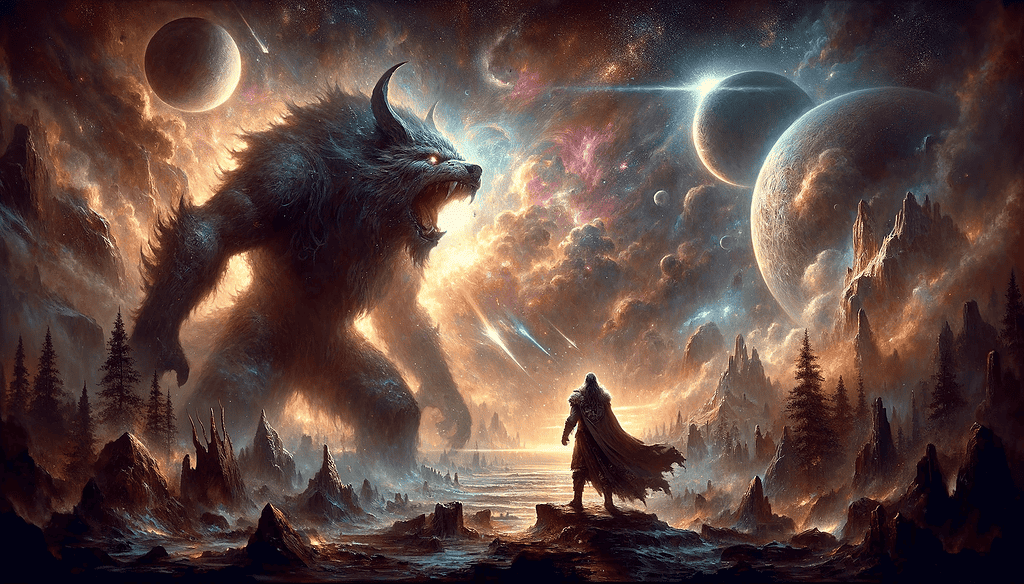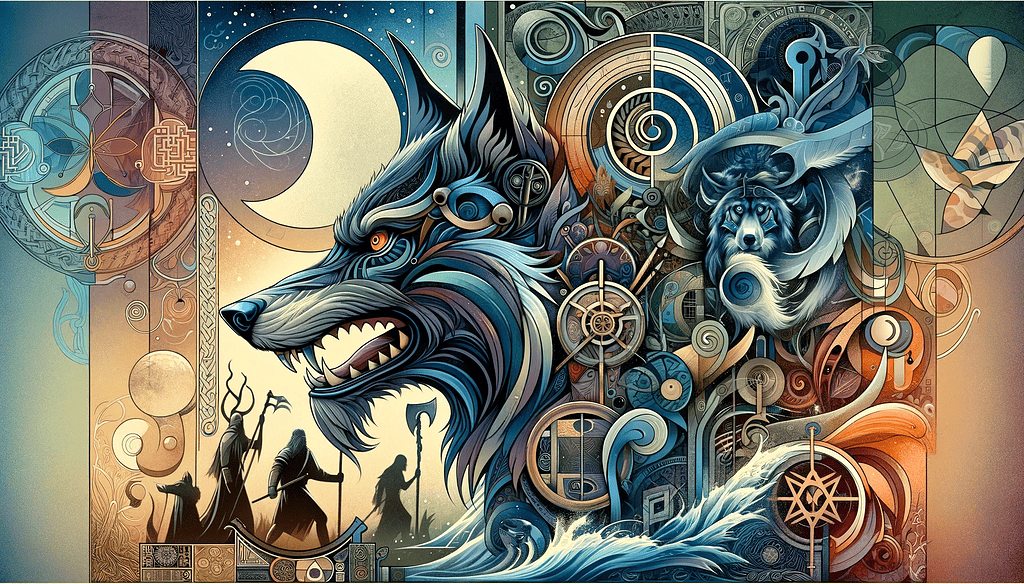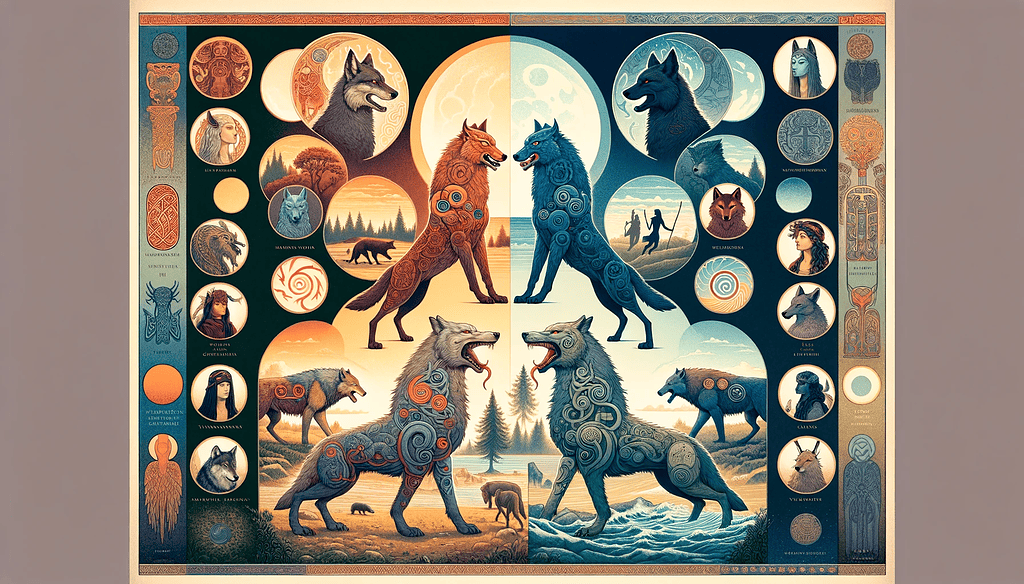Norse mythology, with its rich tapestry of gods, giants, and mythical creatures, offers a fascinating glimpse into the beliefs and values of the ancient Norse people.
Among its pantheon of characters, few are as compelling and complex as the great wolf Fenrir. This mythical creature, born from the loins of the trickster god Loki and the giantess Angrboda, stands as a towering figure in the sagas, embodying the primal forces of nature and the inevitability of fate.
Our journey into this ancient world will unravel the layers of meaning behind Fenrir, shedding light on why this emblematic beast continues to captivate the imagination of those who walk the paths of Norse paganism and witchcraft today.

Table of Contents
The Genesis of Fenrir: From Myth to Legend
Son of Loki and Angrboda
The tale of Fenrir begins in the shadowy realms of Norse mythology, where his birth intertwines the fates of gods and monsters. As the offspring of Loki, the enigmatic god known for his cunning and deceit, and Angrboda, a formidable giantess from the land of giants, Fenrir’s lineage was remarkable from the start. This unique heritage imbued him with extraordinary strength and a destiny that would forever entwine him with the cosmic events of the Norse cosmos.
Growing Threat to the Aesir Gods
From the moment of his birth, Fenrir’s size and strength grew at an astonishing rate, a physical manifestation of his formidable heritage. The Aesir gods, ever watchful of potential threats to their dominion, observed Fenrir’s growth with a mix of awe and apprehension. This growing unease among the gods was not unfounded; they were acutely aware of the prophecies foretelling their downfall, a cataclysm in which Fenrir was destined to play a pivotal role.
The gods’ attempts to curb Fenrir’s burgeoning power reflect their profound struggle against the inescapable web of fate, highlighting a central theme in Norse mythology: the tension between destiny and the desire to forge one’s own path. As Fenrir continued to grow, both in size and in the fear he instilled in the hearts of the Aesir, the stage was set for a series of events that would test the bonds of trust, loyalty, and power in the ancient Norse pantheon.

Fenrir’s Symbolism in Norse Culture
The Wolf Archetype
In the tapestry of Norse mythology, the wolf occupies a space shrouded in duality, revered as a symbol of fierce loyalty and family bonds, yet feared for its raw, untamed power and predatory nature. This archetype reaches its zenith in the figure of Fenrir, who embodies the full spectrum of the wolf’s symbolic meanings.
Fenrir’s immense power and ferociousness amplify the fear and respect that the Norse people held for wolves, making him a figure of awe and a symbol of the untamable forces that lie beyond the bounds of civilization. His story reflects the deep connection and reverence the Norse felt towards the natural world, acknowledging its beauty and its danger.
Harbinger of Ragnarok
Fenrir’s most profound symbolism lies in his role as the harbinger of Ragnarok, the prophesied end of the world in Norse mythology. This cataclysmic event was seen not just as the destruction of the present world but as a necessary precursor to renewal and rebirth. Fenrir, in his breaking free during Ragnarok, embodies the inevitable dissolution of the old order, making way for the new.
His destined battle with the gods, leading to the fall of Odin, signifies the cyclical nature of existence in Norse belief, where endings are always followed by beginnings. This portrayal of Fenrir as both destroyer and catalyst for renewal encapsulates the Norse understanding of the cyclical nature of life and the universe, where chaos and order are perpetually intertwined, each giving meaning to the other.

The Binding of Fenrir: A Tale of Deception and Fate
The Magical Chains
The saga of Fenrir’s binding is a riveting narrative woven with the threads of cunning, magic, and the inescapable grip of destiny. As the Aesir gods grappled with the threat Fenrir posed, they turned to the dwarves’ unparalleled craftsmanship to create Gleipnir, a chain unlike any other.
Crafted from the sound of a cat’s footfall, a woman’s beard, the roots of a mountain, the sinews of a bear, the breath of a fish, and a bird’s spittle, Gleipnir’s strength lay in its improbable origins, making it both impossibly strong and deceptively delicate in appearance. This tale embodies the Norse belief in the power of the unseen and the unpredictable, where even the mightiest force can be bound by the most ethereal of bindings, suggesting a world where power is as much about wisdom and cunning as it is about brute force.
Tyr’s Sacrifice
In the heart of this myth lies the poignant story of Tyr, the god of war and justice, whose bravery shines forth in a moment of profound sacrifice. As the only god courageous enough to place his hand in Fenrir’s mouth as a pledge of good faith during the attempt to bind the great wolf, Tyr’s subsequent loss of his hand when Fenrir realizes the deception is a stark testament to the themes of trust, betrayal, and sacrifice.
This act not only underscores the gravity of the gods’ decision to bind Fenrir but also highlights the complex nature of heroism in Norse mythology. Heroism, in this context, is not without cost, and the greatest acts of valor often entail great personal sacrifice, reflecting a deeply ingrained cultural acknowledgment of the intertwined nature of fate, duty, and honor.

Fenrir in the Final Battle: Ragnarok Unleashed
Release and Revenge
As the threads of destiny wove toward the climax of Ragnarok, the apocalyptic prophecy within Norse cosmology, Fenrir’s role shifted from captive to cataclysmic force. The breaking of Gleipnir, the magical chain, marked not only Fenrir’s release but also the beginning of the end; the world trembled as the boundaries between order and chaos dissolved.
Fenrir’s emergence from bondage was a herald of the cycle of destruction and rebirth intrinsic to Ragnarok, embodying the violent upheaval necessary for the renewal of the cosmos. This moment underscored the Norse belief in the inevitability of change and the natural cycle of endings leading to new beginnings.
The Epic Confrontation
The climax of Fenrir’s saga culminates in a battle of cosmic proportions, pitting him against the mightiest of the Aesir gods, Odin. This epic confrontation, foretold since the dawn of the myths, was charged with the fatalism of preordained fate, as both participants were bound to their roles by the unyielding threads of destiny.
Fenrir’s immense jaws, capable of spanning the heavens, met Odin in a clash that echoed the primal forces of creation and destruction. In the wake of Odin’s fall, a pivotal moment of vengeance and justice unfolded as Vidarr, Odin’s son, stepped forward to avenge his father. Employing a specially crafted shoe, Vidarr was able to tear apart Fenrir’s massive jaws, bringing an end to the great wolf’s reign of terror.
This act of retribution by Vidarr not only fulfilled the cycle of vengeance that is a recurrent theme in Norse tales but also illustrated the nuanced interplay of fate, valor, and the eternal struggle between order and chaos.

Fenrir’s Legacy in Modern Culture
From Mythology to Modernity
Fenrir’s transition from the annals of Old Norse epics to a prominent symbol in modern culture illustrates the timeless allure of Norse myths. Rooted in the Poetic Edda and Prose Edda, Fenrir’s tale has transcended time, continuing to fascinate and inspire.
This leap from the Viking Age to today showcases the significant role such myths play in our understanding of ancient cultures and their lasting impact on contemporary narratives. As symbols of strength, wolves, particularly Fenrir, embody the raw, untamed essence of the natural world, a theme that resonates deeply with people today.
Symbolic Meanings Today
In modern culture, the symbol of the wolf, especially as epitomized by Fenrir, carries layers of meaning. From the twilight of the gods to the representation in various styles of art, literature, and media, Fenrir’s image has evolved to embody a spectrum of interpretations. This evolution reflects a shift from the traditional Norse portrayal of the wolf deity to a more nuanced symbol that resonates with the modern ethos of resilience, freedom, and the cycle of life and death.
The story of Fenrir, particularly his crucial role in the celestial events leading to Ragnarok, continues to be a source of inspiration, offering a bridge between the ancient world and the contemporary, between the gods of Asgard and the people of today.
Fenrir in Contemporary Paganism and Witchcraft
For practitioners of Norse paganism and witchcraft, Fenrir holds a special place as a potent symbol of transformation and challenge to the status quo. His narrative, from the bindings of Gleipnir to the final battle, serves as a metaphor for personal and communal struggles against constraining forces.
In this context, Fenrir’s story is not just an echo from the past but a living tradition that informs spiritual practice and symbolic language, connecting the ancient with the modern in a continuum of myth and meaning.

Fenrir’s Influence on Art and Symbolism
Artistic Depictions Through the Ages
Fenrir’s imposing figure and dramatic narrative have made him a compelling subject for artists throughout history, from the Viking Age to the modern era. In ancient times, Fenrir was often depicted in carvings and on runestones, his form a symbol of strength and the formidable power of nature. As we move into the Middle Ages and beyond, Fenrir’s image evolves, appearing in various styles of art, from intricate manuscript illustrations to grand paintings, each capturing the essence of his myth in the context of the time period.
Symbolism in Jewelry and Craftsmanship
In Norse culture, symbols carried profound meanings, often worn as arm rings or etched into weaponry and tools. The image of the wolf, especially representations of Fenrir, served as a potent symbol of protection, strength, and loyalty. Today, this tradition continues in modern craftsmanship, with Fenrir and other Norse symbols adorning jewelry, clothing, and decorative items. These pieces not only pay homage to the rich tapestry of Norse mythology but also serve as amulets and talismans for those who feel a connection to these ancient symbols and their meanings.
Fenrir in Literature and Pop Culture
The story of Fenrir has permeated various facets of literature and pop culture, from classical works to contemporary fantasy novels and films. His character and the themes he embodies—freedom, chaos, and the inevitable cycle of destruction and rebirth—are explored in numerous contexts, reflecting society’s enduring fascination with this mythological wolf.
This section of the article could delve into specific examples of Fenrir’s influence on literature and popular media, examining how different cultures and time periods have reimagined his story to reflect their own values and fears.
Fenrir’s Role in Environmental and Natural Symbolism
The Wolf in Natural Ecosystems
Fenrir, as a symbol of the wolf, invites a deeper reflection on the role of real wolves in natural ecosystems. In Norse mythology, wolves are powerful, ambiguous figures, and this complexity mirrors the real-world dynamics of wolves in the wild. By exploring Fenrir’s myth, we can draw parallels to the importance of wolves in maintaining the health and balance of ecosystems, highlighting their role as keystone species in various habitats around the world.
Mythology and Environmental Consciousness
The story of Fenrir can also serve as a catalyst for discussions on environmental preservation and our relationship with the natural world. Norse myths, with their rich depictions of the natural world and its forces, offer a unique lens through which to view contemporary environmental issues. This section of the article could explore how the themes of balance, destruction, and renewal in Fenrir’s story resonate with current efforts to protect natural habitats and preserve biodiversity.
Fenrir in Astrology and Astronomy
Given the celestial bodies involved in Norse myths, such as the sun and moon chased by Fenrir’s offspring, Sköll and Hati, this section could delve into the mythological wolf’s influence on our understanding of the cosmos.
It could explore how ancient Norse people might have interpreted astronomical events through the lens of mythology, and how these interpretations reflect broader human attempts to find meaning in the movements of the stars and planets. This exploration could connect Fenrir’s myth to broader themes of time, cycles, and the human quest for understanding in a vast, mysterious universe.
Fenrir in Comparative Mythology
A table comparing Fenrir’s role and symbolism in Norse mythology with similar wolf figures in other cultural mythologies is a fascinating perspective on common themes and unique interpretations across different cultures.
| Culture | Mythological Wolf | Role in Mythology | Symbolism |
|---|---|---|---|
| Norse (Fenrir) | Fenrir | Destined to fight the gods during Ragnarok, leading to the destruction and rebirth of the world. | Chaos, destruction, strength, challenges to authority, the cycle of life and death. |
| Greek | Lycaon | Turned into a wolf by Zeus; associated with the story of the flood and the restart of humanity. | Punishment, transformation, the primal and untamed aspects of nature. |
| Roman | Lupa | The she-wolf who nursed Romulus and Remus, the founders of Rome. | Nurturing, strength, the foundation of civilization, protection. |
| Celtic | Mac Tire | Wolves in Celtic mythology are often seen as guides or helpers, associated with warriors and transformation. | Guidance, transformation, warriors, the boundary between the worlds. |
| Native American | Various | Wolves appear as teachers, guides, and symbols of strength and wisdom in many stories across tribes. | Teaching, wisdom, social connections, strength, and the importance of the individual within the community. |

Fenrir’s Pop Culture Rolodex
Dive into the fascinating world of Fenrir as he leaps from ancient manuscripts into the heart of modern entertainment. Below is a list showcasing some of the most memorable appearances of this legendary wolf across various media platforms:
- Movies & TV:
- “Thor: Ragnarok” – Witness Fenrir’s cinematic rendition as he battles the gods in this Marvel blockbuster.
- “Vikings” – Explore various interpretations of Norse mythology, including elements inspired by Fenrir’s lore.
- Video Games:
- “God of War” series – Experience the thrilling Norse saga where Fenrir’s descendants play pivotal roles.
- “Smite” – Take control of Fenrir himself in this mythological online battleground.
- Literature:
- “Magnus Chase and the Gods of Asgard” by Rick Riordan – Delve into this young adult series where Fenrir’s character adds depth and intrigue.
- “The Gospel of Loki” by Joanne M. Harris – Discover a novel where Fenrir, from his father Loki’s perspective, presents an interesting twist.
- Fan Theories & Discussions:
- Reddit’s r/NorseMythology and r/GodofWar – Join the discussions where fans theorize Fenrir’s influence in Norse mythology and modern interpretations.
Fenrir: A Legacy Beyond the Norse Myths
Fenrir’s story, woven into the fabric of Norse mythology, extends far beyond the ancient texts of the Poetic Edda and Prose Edda. As a figure of immense power, bound by fate yet yearning for freedom, he captivates our imagination, urging us to explore the depths of our own beliefs about destiny, strength, and the cyclical nature of the cosmos.
His tale, rich with themes of loyalty, betrayal, and the inevitable confrontation with one’s fate, resonates across cultures and epochs, embodying the timeless struggle between order and chaos. Fenrir’s legacy, from the Old Norse sagas to modern interpretations, continues to inspire and challenge us, offering profound insights into the human condition and our place within the natural world.
Check out these other categories:
